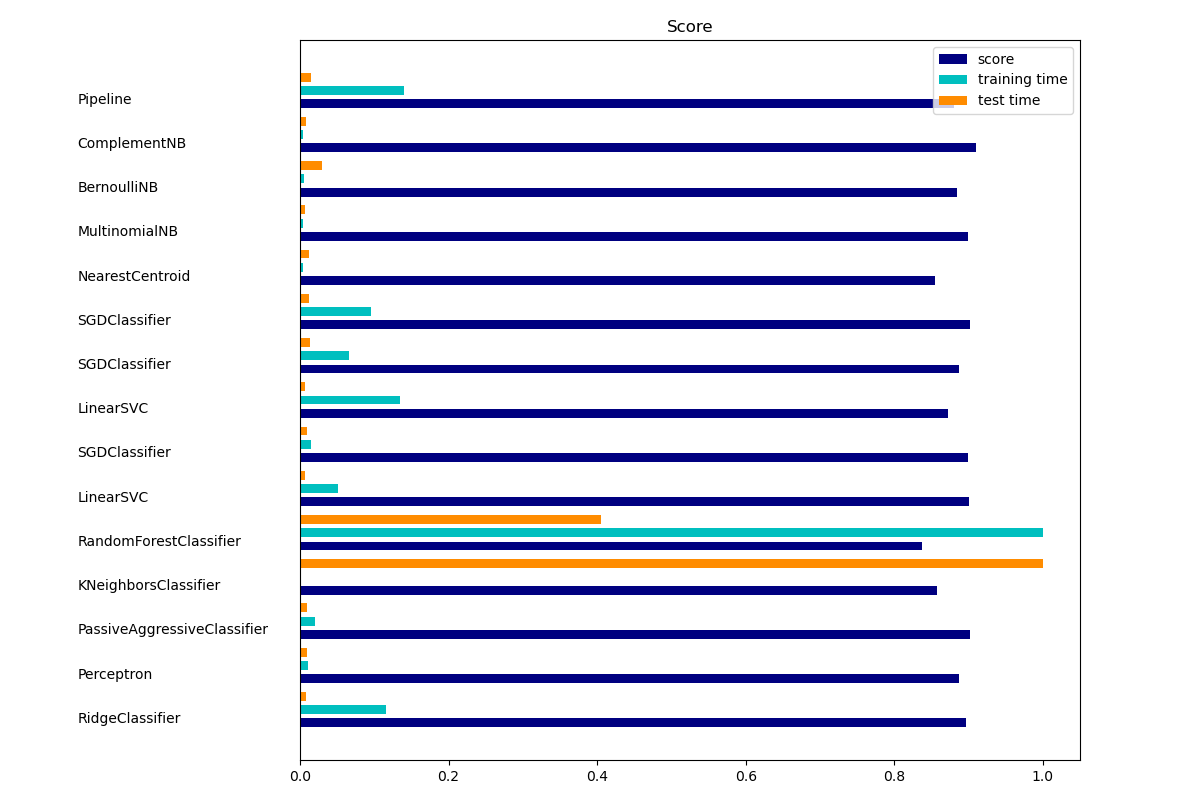sklearn.linear_model.RidgeClassifier?
class sklearn.linear_model.RidgeClassifier(alpha=1.0, *, fit_intercept=True, normalize=False, copy_X=True, max_iter=None, tol=0.001, class_weight=None, solver='auto', random_state=None)
使用Ridge回歸的分類器。
該分類器首先將目標值轉換為{-1, 1},然后將問題視為回歸任務(在多類情況下為多輸出回歸)。
在用戶指南中閱讀更多內容。
| 參數 | 說明 |
|---|---|
| alpha | float, default=1.0 正則強度,必須為正浮點數。正則化改善了問題的狀況,并減少了估計的方差。較大的值表示更強的正則化。在其他線性模型中,Alpha對應于 1 / (2C),例如 LogisticRegression或sklearn.svm.LinearSVC |
| fit_intercept | bool, default=True 是否計算此模型的截距。如果設置為false,則在計算中將不使用截距(如數據已經中心化)。 |
| normalize | bool, default=Falsefit_intercept設置為False 時,將忽略此參數。如果為True,則在回歸之前通過減去均值并除以l2-范數來對回歸變量X進行歸一化。如果你希望標準化,請先使用 sklearn.preprocessing.StandardScaler,然后調用fit 估算器并設置normalize=False。 |
| copy_X | bool, default=True 如果為True,將復制X;否則,X可能會被覆蓋。 |
| max_iter | int, default=None 共軛梯度求解器的最大迭代次數。默認值由scipy.sparse.linalg確定。 |
| tol | float, default=1e-3 優化算法的精度。 |
| class_weight | dict or ‘balanced’, default=None 以 {class_label: weight}的形式與類別關聯的權重。如果沒有給出,所有類別的權重都應該是1。“balanced”模式使用y的值來自動調整為與輸入數據中的類頻率成反比的權重。如 n_samples / (n_classes * np.bincount(y)) |
| solver | {‘auto’, ‘svd’, ‘cholesky’, ‘lsqr’, ‘sparse_cg’, ‘sag’, ‘saga’}, default=’auto’ 用于計算例程的求解器: - “auto”會根據數據類型自動選擇求解器。 - “ svd”使用X的奇異值分解來計算Ridge系數。對于奇異矩陣,比“ Cholesky”更穩定。 - 'cholestsky'使用標準的scipy.linalg.solve函數獲得封閉形式的解決方案。 - 'sparse_cg'使用scipy.sparse.linalg.cg中的共軛梯度求解器。作為一種迭代算法,對于大規模數據(可以設置 tol和max_iter),此求解器比“ Cholesky”更合適。- “ lsqr”使用專用的正則化最小二乘算法scipy.sparse.linalg.lsqr。它是最快的,并且使用了迭代過程。 - “sag”使用隨機平均梯度下降,而“saga”是它的無偏和更靈活的版本。這兩種方法都使用了迭代過程,當n_samples和n_features都很大時,通常比其他求解器更快。請注意, “sag”和“saga”的快速收斂只能保證在具有大致相同規模的特性上。你可以使用sklearn.preprocessing中的縮放器對數據進行預處理。 *0.17版本中的新功能:*隨機平均梯度下降求解器。 0.19版中的新功能: SAGA求解器。 |
| random_state | int, RandomState instance, default=None 在 solver=='sag'或'saga'時使用,用于隨機打亂數據。有關詳細信息,請參見詞匯表。 |
| 屬性 | 說明 |
|---|---|
| coef_ | ndarray of shape (1, n_features) or (n_classes, n_features) 決策函數中特征的系數。 當給定問題為二分類時, coef_形狀為(1,n_features)。 |
| intercept_ | float or ndarray of shape (n_targets,) 決策函數中的截距。如果設置 fit_intercept = False,則截距為0.0 。 |
| n_iter_ | None or ndarray of shape (n_targets,) 每個目標的實際迭代次數。僅適用于sag和lsqr求解器。其他求解器將返回None。 |
| classes_ | ndarray of shape (n_classes,) 類別標簽。 |
另見
嶺回歸。
帶有內置交叉驗證的Ridge分類器。
注
對于多類別分類,以“一對多”的方法訓練n_class分類器。具體而言,這是通過利用Ridge中的多變量響應支持來實現的。
示例
>>> from sklearn.datasets import load_breast_cancer
>>> from sklearn.linear_model import RidgeClassifier
>>> X, y = load_breast_cancer(return_X_y=True)
>>> clf = RidgeClassifier().fit(X, y)
>>> clf.score(X, y)
0.9595...
方法
| 方法 | 說明 |
|---|---|
decision_function(self, X) |
預測樣本的置信度得分。 |
fit(self, X, y[, sample_weight]) |
擬合Ridge分類器模型。 |
get_params(self[, deep]) |
獲取此估計器的參數。 |
predict(self, X) |
預測X中樣本的類別標簽。 |
score(self, X, y[, sample_weight]) |
返回給定測試數據和標簽上的平均準確度。 |
set_params(self, **params) |
設置此估計器的參數。 |
__init__(self, alpha=1.0, *, fit_intercept=True, normalize=False, copy_X=True, max_iter=None, tol=0.001, class_weight=None, solver='auto', random_state=None)
初始化self, 請參閱help(type(self))以獲得準確的說明。
decision_function(self, X)
預測樣本的置信度得分。
樣本的置信度分數是該樣本到超平面的符號距離。
| 參數 | 說明 |
|---|---|
| X | array_like or sparse matrix, shape (n_samples, n_features) 樣本數據。 |
| 返回值 | 說明 |
|---|---|
| array, shape=(n_samples,) if n_classes == 2 else (n_samples, n_classes) 每個(樣本,類別)組合的置信度得分。在二分類情況下,self.classes_ [1]的置信度得分> 0表示將預測該類。 |
fit(self,X,y,sample_weight = None )
[源碼]
擬合Ridge分類器模型。
| 參數 | 說明 |
|---|---|
| X | {ndarray, sparse matrix} of shape (n_samples, n_features) 訓練數據 |
| y | ndarray of shape (n_samples,) 目標標簽。 |
| sample_weight | float or ndarray of shape (n_samples,), default=None 每個樣本的權重,如果使用浮點數,每個樣品的權重都相同。 0.17版中的新功能:sample_weight支持Classifier。 |
| 返回值 | 說明 |
|---|---|
| self | object 估計器的實例。 |
get_params(self,deep = True )
[源碼]
獲取此估計器的參數。
| 參數 | 說明 |
|---|---|
| deep | bool, default=True 如果為True,返回此估計器和所包含子對象的參數。 |
| 返回值 | 說明 |
|---|---|
| params | mapping of string to any 參數名稱映射到其值。 |
predict(self, X)
[源碼]
預測X中樣本的類別標簽。
| 參數 | 說明 |
|---|---|
| X | array_like or sparse matrix, shape (n_samples, n_features) 樣本數據 |
| 返回值 | 說明 |
|---|---|
| C | array, shape [n_samples] 每個樣本的預測類別標簽。 |
score(self,X,y,sample_weight = None )
[源碼]
返回給定測試數據和標簽上的平均準確度。
在多標簽分類中,這是子集準確性,這是一個嚴格的指標,因為你需要為每個樣本正確預測對應的標簽集。
| 參數 | 說明 |
|---|---|
| X | array-like of shape (n_samples, n_features) 測試樣本。 |
| y | array-like of shape (n_samples,) or (n_samples, n_outputs) X的真實標簽。 |
| sample_weight | array-like of shape (n_samples,), default=None 樣本權重。 |
| 返回值 | 說明 |
|---|---|
| score | float 預測標簽與真實標簽的平均準確度 |
set_params(self, **params)
[源碼]
設置并驗證估計器的參數。
| 參數 | 說明 |
|---|---|
| **params | dict 估計器參數。 |
| 返回值 | 說明 |
|---|---|
| self | object 估計器實例。 |

